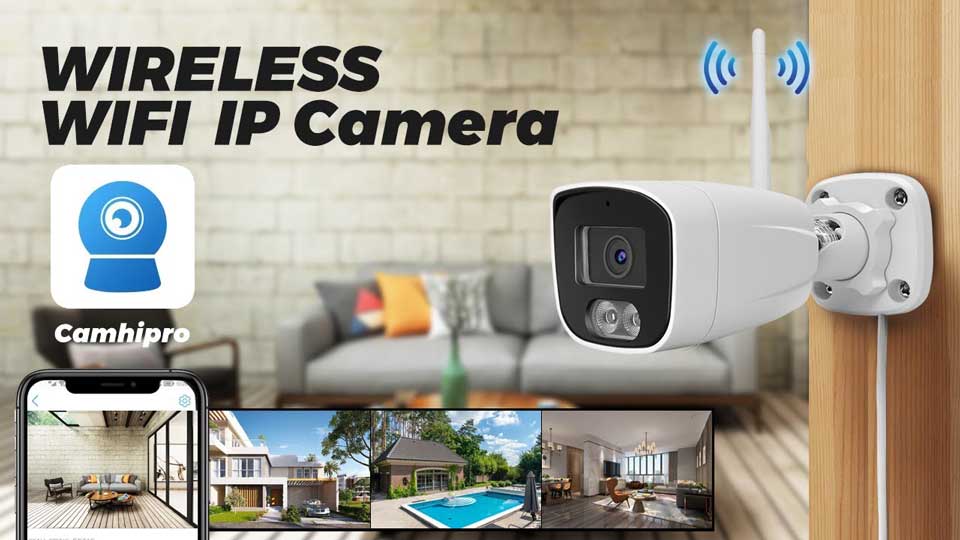CamhiPro user manual, A powerful real-time monitoring security app, so that you care about, become safe, real-time control. You can use it in your home, shop, office, etc., whatever you want to care about, let us be your time Keeper! Time zone Settings and mobile phone time Synchronization video playback in the SD Card take photo for real-time video view the real-time video ptz control..
CamhiPro user manual
How to add CamHi camera to Ispy
1, RTSP to add
1、main stream:rtsp://ip address/11
2、vice stream:rtsp://ip address/12
Find “FFMPEG (H264)” this column, fill in information of RTSP in the URL.After adding can test is successful

Go to “Camera” option.
Input your camera ip address, User name and Password, click “Finish”, add camera succeed.

The difference between camhi and camhipro
The camera can use camhi and camhipro app at the same time, camhipro’s interface design is more modern, except for the interface there is no other difference, the functions are the same
Read Next : CamHi for PC guide and download
Other functions
Camera list display mode
Click the camera list interface icon ![]() to select the camera list in large or small image mode.
to select the camera list in large or small image mode.
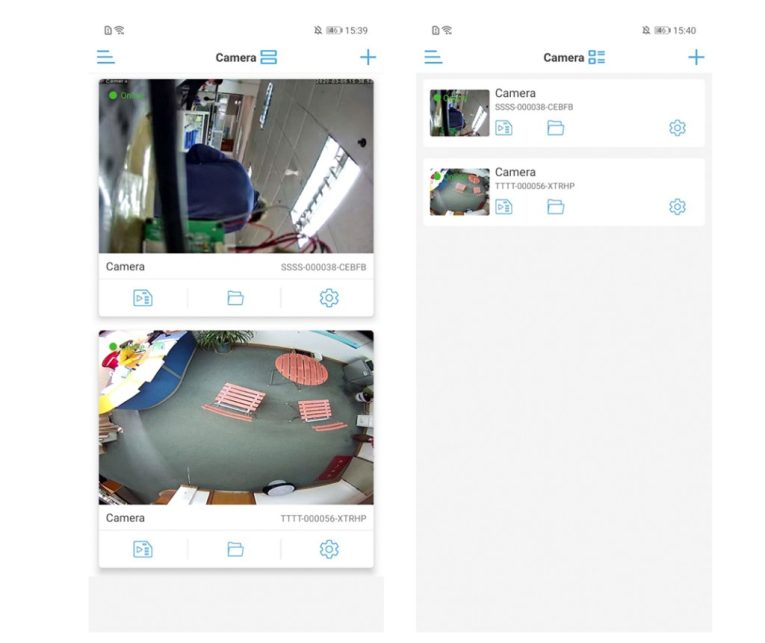
Sidebar settings
Click the camera list interface button![]() , or swipe the screen to the right in the camera list interface to enter the APP sidebar. The APP name is displayed on the sidebar. the below displays APP version.
, or swipe the screen to the right in the camera list interface to enter the APP sidebar. The APP name is displayed on the sidebar. the below displays APP version.
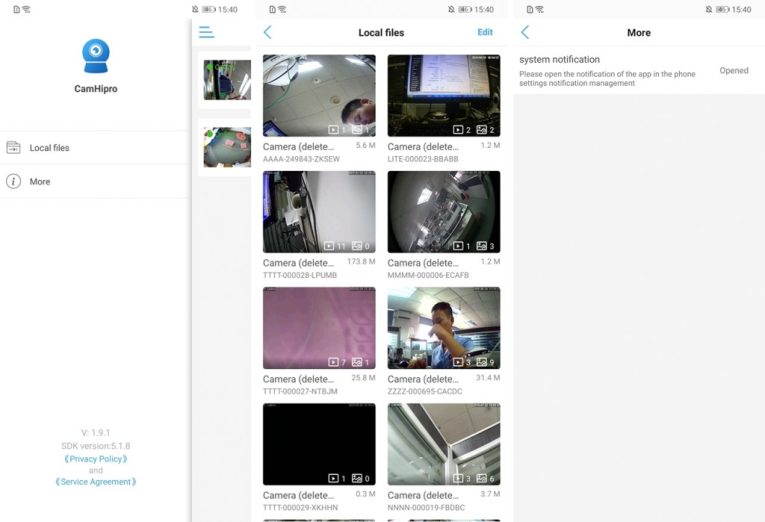
Click Local File to enter the local file interface. This interface displays all the local videos and pictures saved by this camera on this phone. Click on the file to playback the video file or view the local picture. Click the Edit button to delete the file.
Click the More button to check whether the APP has obtained the notification permission of the mobile phone. If the display is not enabled, the APP cannot send the alarm push message. Clicking enabled, you can jump to the setting interface to open the notification permission.
Video/Image search and view
Local recording playback and download
Find the camera to be viewed in the camera list interface, click the icon![]() , select the recording page, the recording file will be displayed, you can sort according to the size and length of the video file, click the button
, select the recording page, the recording file will be displayed, you can sort according to the size and length of the video file, click the button![]() , you can save the video file to the mobile phone album. Click the edit button, it can delete the selected video file.
, you can save the video file to the mobile phone album. Click the edit button, it can delete the selected video file.
View local snapshot images
Click on the image page in the local file interface, the local snapshot images will be displayed, the images will be sorted according to the capture time, click the preview thumbnail to view the image, click the button![]() , you can delete or save the image to the album.
, you can delete or save the image to the album.

Remote video playback and download
Remote video playback
Click the button “camera list interface![]() ” to enter the remote recording list interface. The APP searches for the last 6 hours of video files by default. You can customize the sorting according to the recording time, click the video file, and then click play to playback the video files in the SD card of the device.
” to enter the remote recording list interface. The APP searches for the last 6 hours of video files by default. You can customize the sorting according to the recording time, click the video file, and then click play to playback the video files in the SD card of the device.
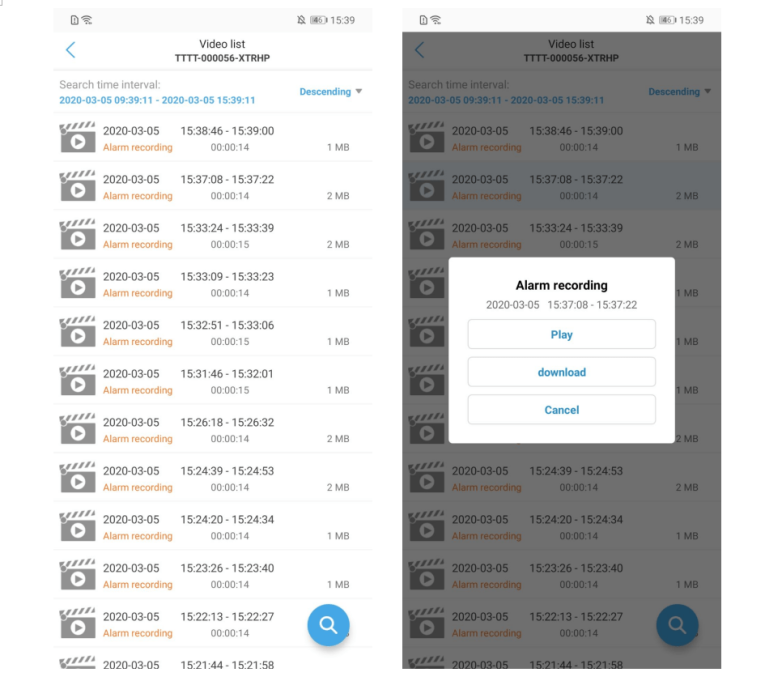
Remote video download
Click on the video file in the recording list interface, and then click Download, the video file will be downloaded automatically. The downloaded video file will be saved in the local recording interface. After the video download is completed, you can click to continue downloading, continue to download other video files, or click view, will jump to the local recording interface automatically.
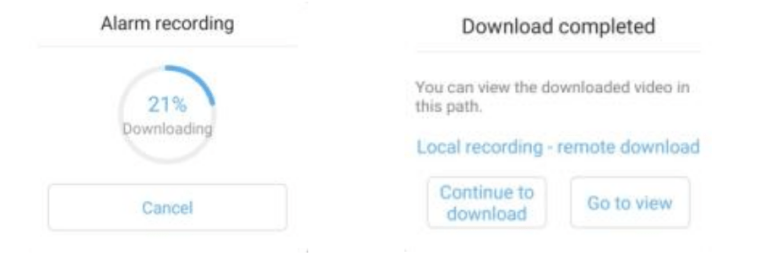
Remote video search
Click the button ![]() on the recording list interface, the search option appears, you can select the recording search range as needed.
on the recording list interface, the search option appears, you can select the recording search range as needed.
Search time range is optional
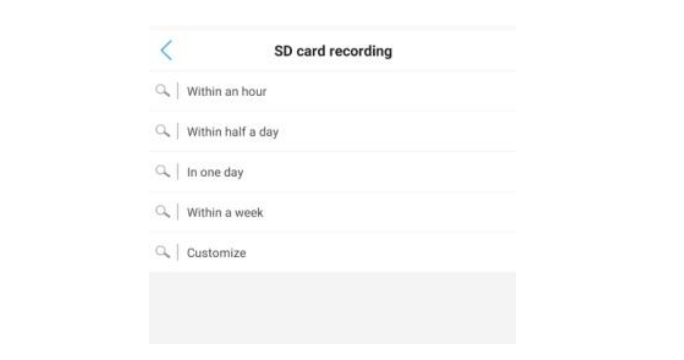
Function settings
When the camera is online, click the camera list interface or the live interface icon ![]() to enter the camera parameter setting interface.
to enter the camera parameter setting interface.
Basic settings
Wifi settings
Display the WIFI network connected to the current device
Click to get the wireless network around the device, the device will search for the WIFI network in the current environment automatically; select the password to configure the WIFI of the current device.
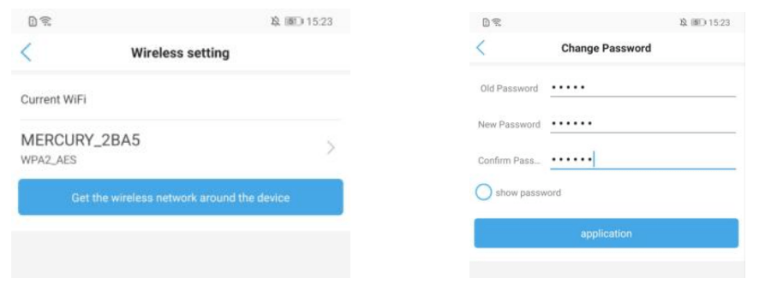
Change password
The access password of the camera can be modified. When ticking display password, the password will be visible.
Alarm settings
Alarm management and notification
Select On to indicate that a push message will be sent to the phone when alarming.
1.Motion detection alarm
Select On to indicate that the device has enabled motion detection. Clicking adjust motion detection, it can draw motion detection area and adjust motion detection sensitivity (This function is suitable for some models.)
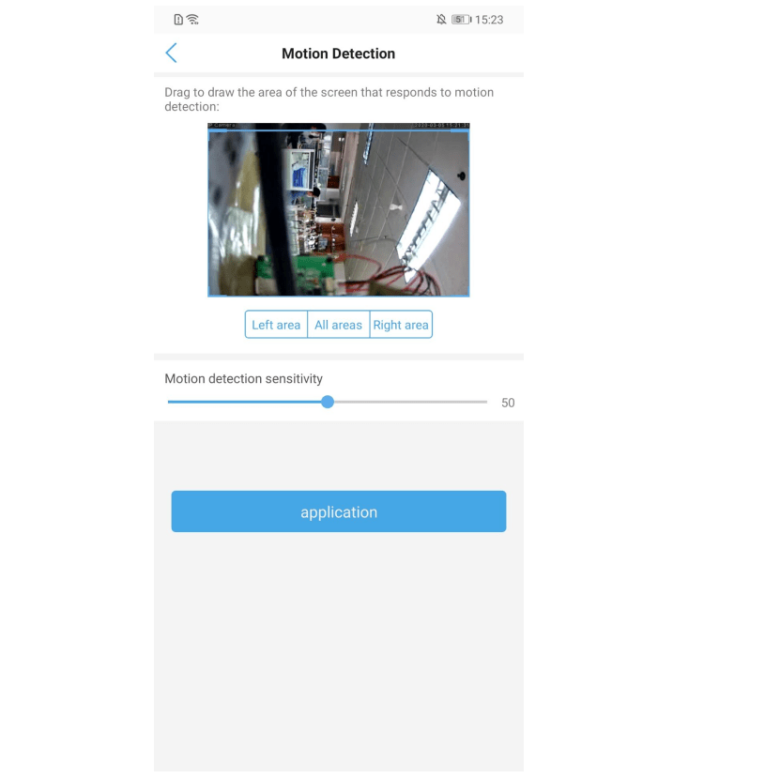
2.Sound alarm
Select On to indicate that the device with microphone function. When the surrounding sound is greater than the intensity of the device check sound, trigger an alarm, click to adjust the sound alarm, you can adjust the sound alarm sensitivity
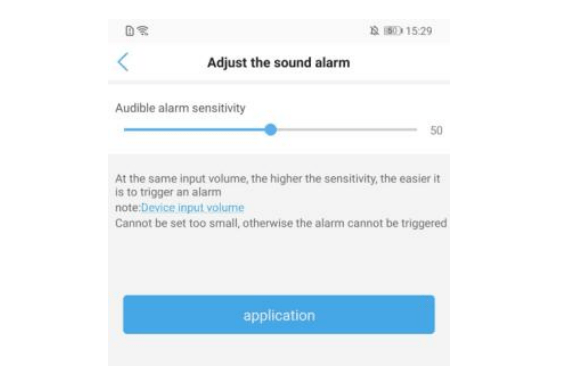
Alarm Linkage
Select On to indicate that the alarm capture picture is saved to the SD card.
Select On to indicate that the alarm recording file is saved to the SD card.
Select on to indicate that when alarming the camera will sound an alarm. Siren type and the duration of the siren is optional
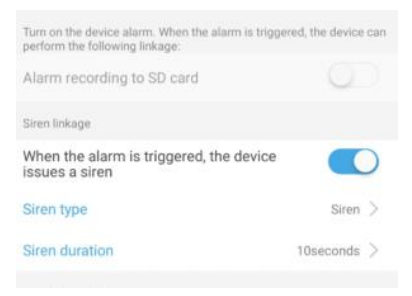
Email alarm linkage
Select On to indicate that the device will trigger the alarm and send a picture to the mailbox. Click Configure Email to set the mailbox information.
Send an email to the QQ mailbox as an example:
Smtp server: smtp.qq.com
Port: 465
Secure connection: SSL
Username: QQ number of the outbox
Password: Authorization code of the outbox QQ mailbox
Receiving address: the mailbox that receives the alarm picture
Sender address: sender email address, here is the QQ mailbox as an example, you need to fill in the QQ email address (consistent with the user name). Subjects and content can be filled in casually. After filling out, click the Apply button, then click the Test button to check if you can send an alarm email.
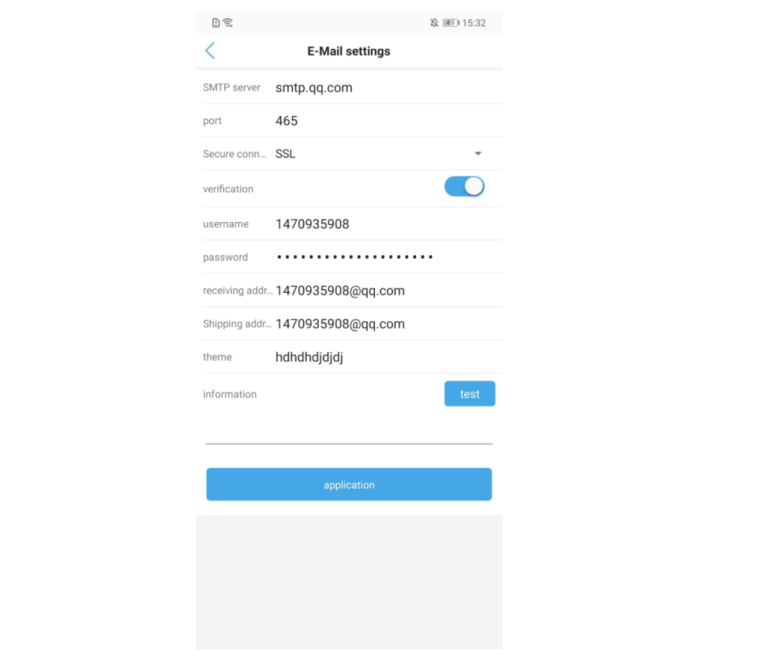
FTP alarm linkage
1.Alarm recording is saved to FTP
Select On to indicate that the alarm recording file is saved to FTP.
2.alarm capture saved to FTP
Select On to indicate that the alarm capture image is saved to FTP.
Click Configure FTP to set FTP information.
Server address: Fill in the erected FTP address
Port: Fill in the FTP port
Username and password: Fill in the username and password set in FTP
After filling in, click the Apply button, then click the Test button to check if you can send an alarm picture to FTP.
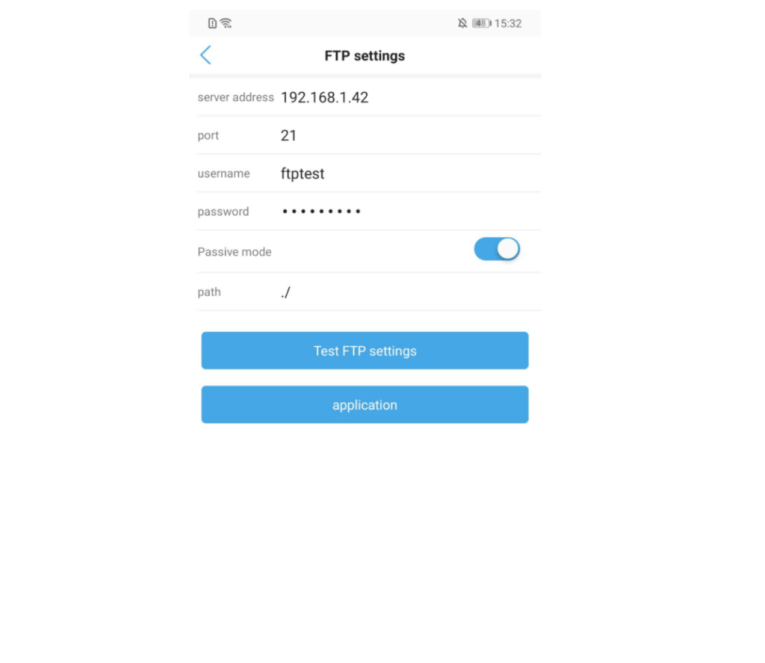
Picture capture number setting
You can set the number of alarm capture pictures, 1-3 sheets are optional
This function is suitable for some models.
Audio/Video management
Video settings
Can customize device’s code rate of first code stream and second code stream
Can customize device’s frame rate of first code stream and second code stream
1-6 can be set, the smaller the value, the better the image level, the larger the code stream
50Hz and 60Hz optional
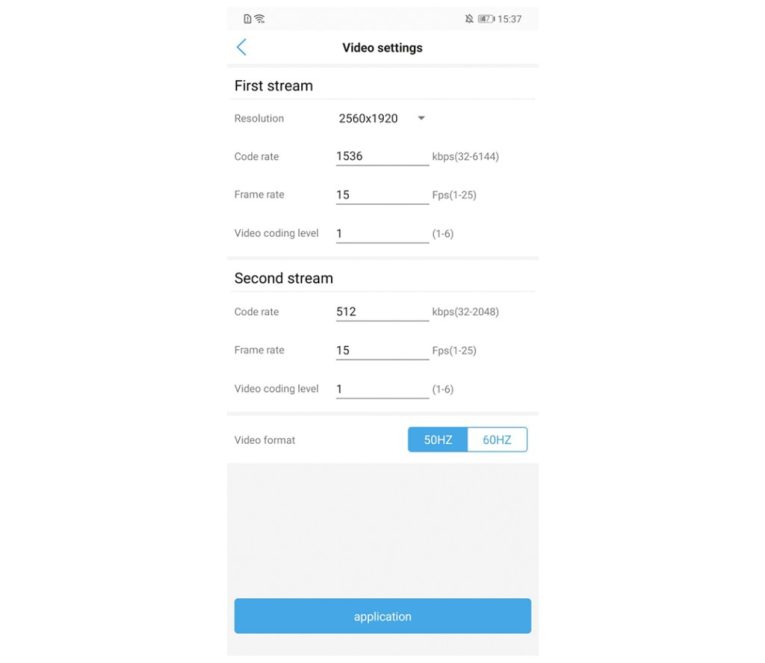
Audio settings
Adjust the input volume of the device
Adjust the output volume of the device
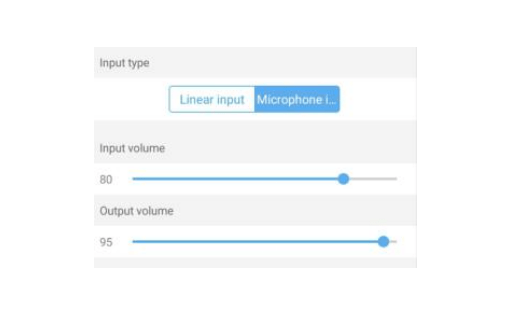
SD Card recording and capacity
SD Card plan recording
Select on, the device will save the recording to SD card
Can adjust the length of each recording file manually.
1.Simple settings
Select Simple settings, the recording time period defaults to Monday-Sunday full-day recording.
2.Advanced settings
Select advanced settings to customize the time period for each day of recording manually
Enter the advanced settings interface, click the quick edit button, select the time period to be recorded, you can customize the recording time period; edit it, clicking the Finish button to save the settings.
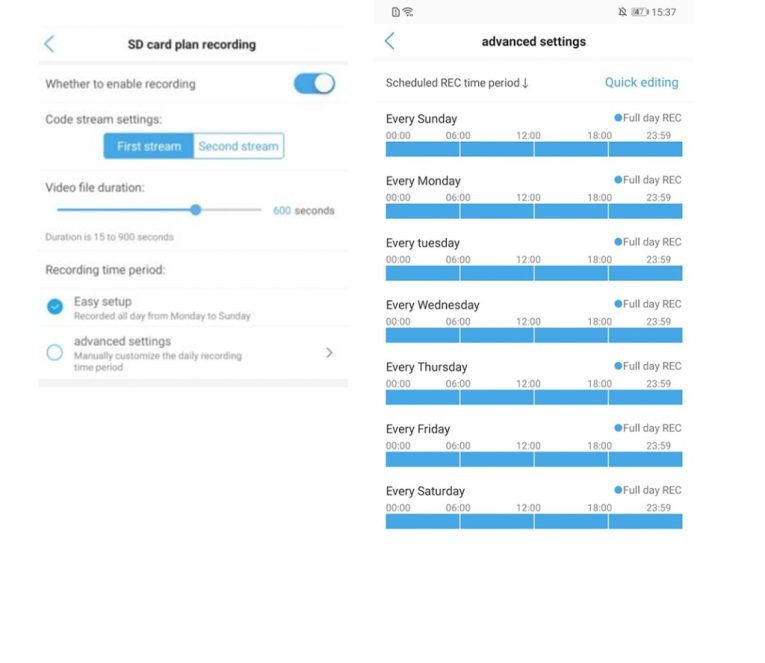
SD Card settings
Can view the total space and free space of the device SD card, can format SD card
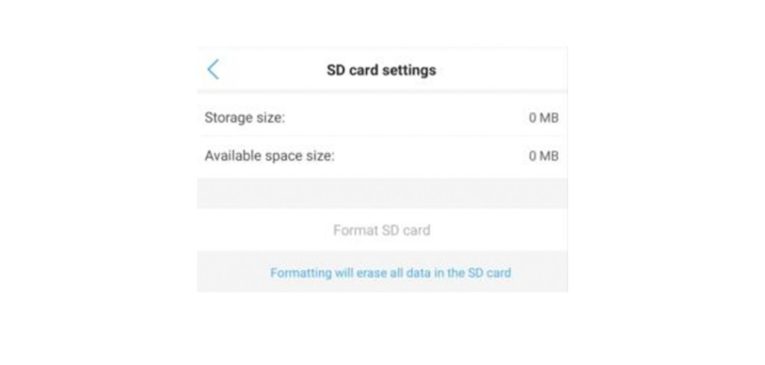
System settings
Device time settings
1、Synchronize device time to phone time
2、The device time zone can be set. After the time zone is set successfully, the device will restart automatically.
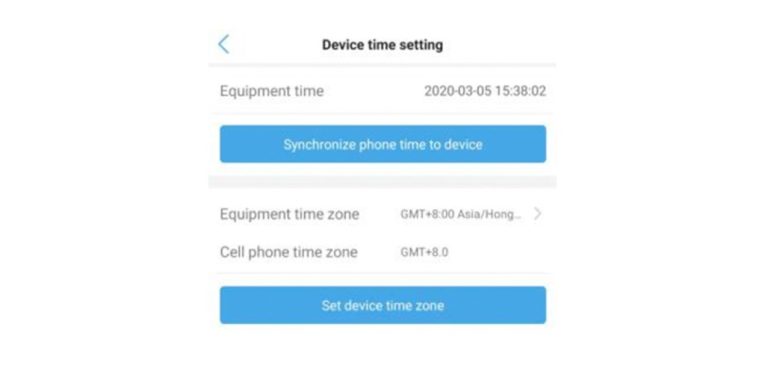
Initial settings
The camera will restart after clicking
The camera will reset after clicking

Device information
Can get the device information of the camera: including device name, device type, Network type, number of user connections, software version, IP address, Subnet mask, gateway, DNS, etc.
Check for updates:
After clicking, the camera will check the firmware version automatically. If there is a new version, it will prompt for updates, click to upgrade online
(This function is suitable for some models)
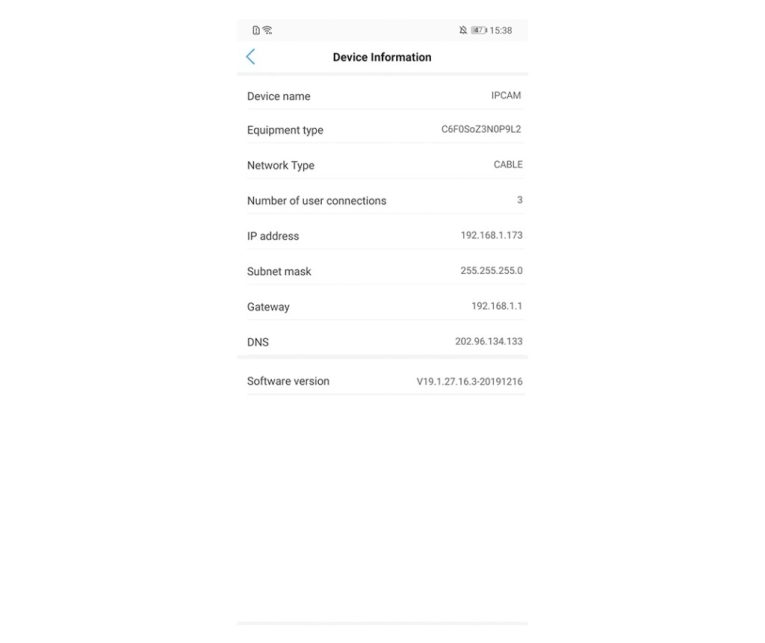
Function description of live broadcast interface
Ordinary camera interface
The ordinary camera monitoring interface is displayed in the small screen mode by default. The function selection button is displayed at the bottom of the screen. More function keys can be called to slide to the left in the blank space. The function description of the buttons is shown in the figure below.
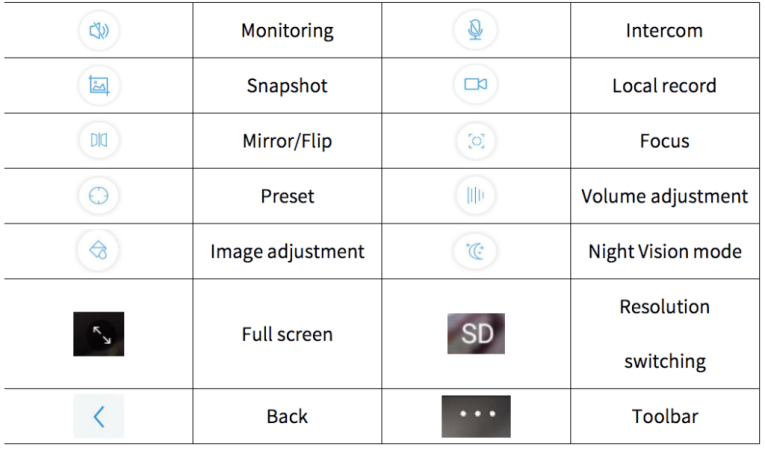
Note: Some functions require device support
PTZ function:
For devices with PTZ function, use your finger to swipe the live video, the camera will rotate according to the direction of the finger.
Exit the live interface:
Press the blank space and pull down on the small screen interface or click the back button to exit the live interface.
Panoramic camera interface
The panoramic camera will have different live broadcast interfaces depending on the model. It subjects to the connected model. The key function description as following:
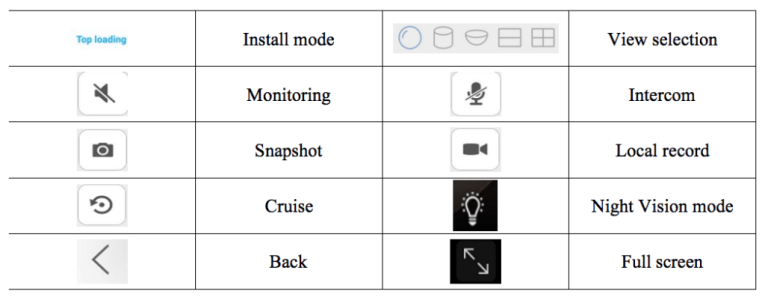
Exit the live interface:
Press the back button to exit the live interface
View the camera
After adding the camera for a few seconds, wait for the camera to connect to the camera automatically, prompt the online description to view the camera video, click on the camera that displays online to enter the camera live interface.
Camera status description:
Connecting: At this time, the camera is establishing a connection with the network camera. According to different networks, the connection time is different.
Online: This status indicates that the device is connected properly; click to view the video;
Not connected: This status indicates that the device is offline
Password error: This status indicates that the camera login password is wrong. Clicking on the camera in this state will pop up the Change Password dialog box.
Add camera
Install the APP, connect the mobile phone to the WIFI network, enter the APP and click the Add Device button to enter the Add Device interface. If it is the first time to use or restore the factory settings: the camera is not connected to the network, clicking the new device; the camera that has connected to the network, clicking on the device in use
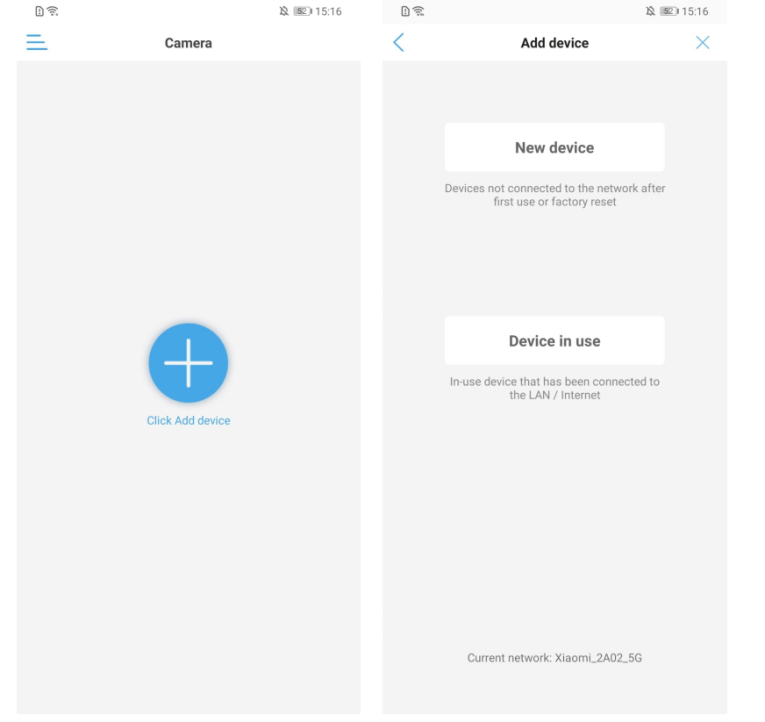
New device add
After clicking the “New Device” button, power on the device, wait for about 30 seconds, confirm that the device is working, click next.
Connected to Network cable
If the device is connected to the network cable, click the “Connected Network Cable” button, the APP will search for the UID of the device in the current LAN automatically. Selecting the UID to be added and click the Add button, the device will search for the nearby WIFI signal automatically to enter the wireless configuration interface. Enter WIFI password, click “Configure wifi and add”, after WIFI configuration successfully, jump to the device list interface; if you do not want to configure WIFI temporarily, click the “Do not configure, directly add” button, adding camera fter confirmation.
Un-connected to Network cable
If the device is not connected to the network cable, click the “Un-Connected to Network Cable” button to enter the interface for selecting the network type.
Sound wave configuration network support equipment: PTZ Camera, Card type camera, Bulb camera, Small flying saucer camera, etc.
AP configuration network support equipment: Box camera, PTZ Camera, Speed dome camera, Big flying saucer camera, etc.
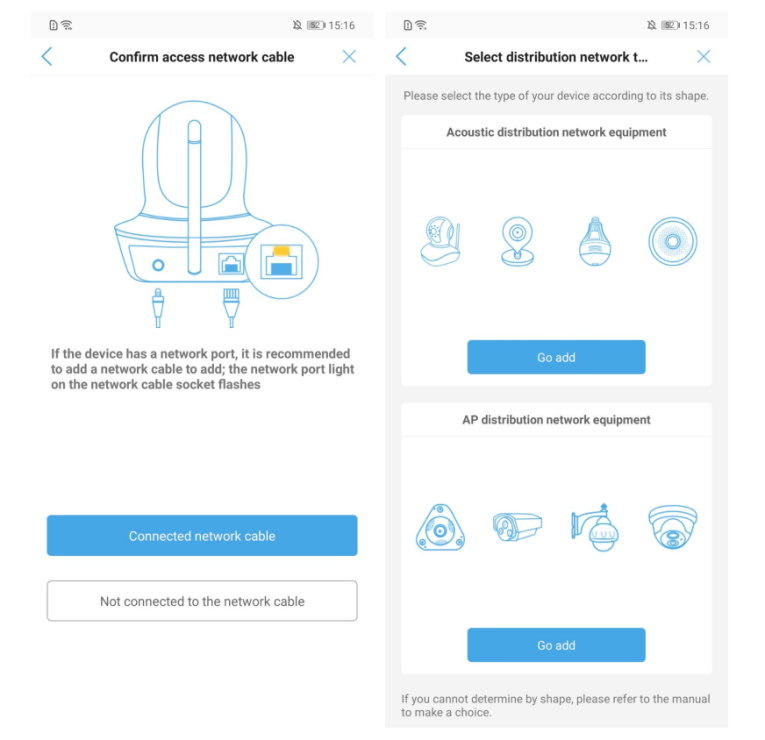
Sound wave configuration network
When the power is turned on, the device will enter the waiting state, and the device will send out a “beep” sound intermittently. Click Next to scan the QR code of the device UID number with the mobile phone. If there is no QR code, click Skip. Enter the password of the WIFI signal to be configured, click to start the sound wave configuration, the system will configuration WIFI automatically. After WIFI configuration successfully, there is a voice prompt
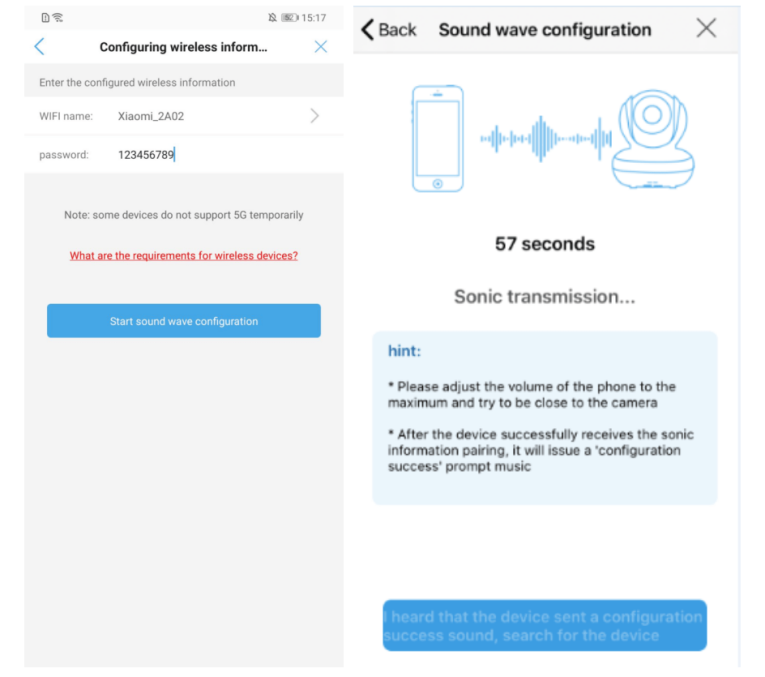
AP configuration network
When the network cable is not connected, turn on the power, click to add, the APP will search for hotspot signals of nearby cameras automatically. The hotspot format is IPCAM-XXXXXX, the password defaults to 01234567. Selecting the hotspot of the camera to be added, clicks connect. After connecting successfully, enter the device add interface, click Add, enter the wireless configuration interface, enter the router’s WIFI password, click “Configure wifi and add”, after WIFI configuration successfully, jump to the device list interface; if you do not want to configure WIFI, click the button ” Don’t configure, add directly”, add camera after confirmation.
Note: AP configuration network needs to open the phone’s GPS function first.
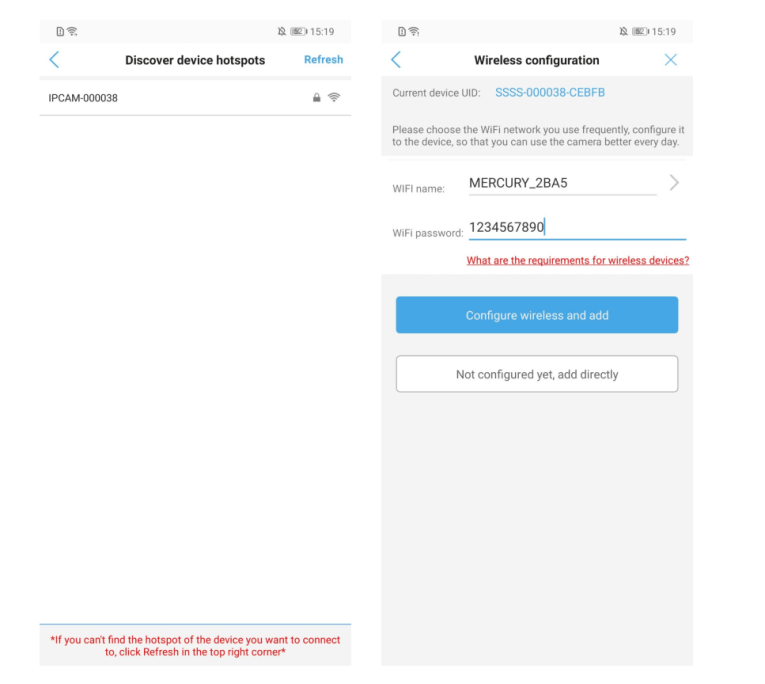
Add device in use
Scan QR code
Generate a QR code by using the online QR code generation tool, and then scan the QR code through the mobile APP to scan and add.
Search for nearby devices
1、Click the button “Search for nearby devices” to search for the ip camera in the wireless network where the phone is located, and select the corresponding UID.
2、Enter the camera password (the camera default password is admin)
3、Click the button “Add” to add a camera.
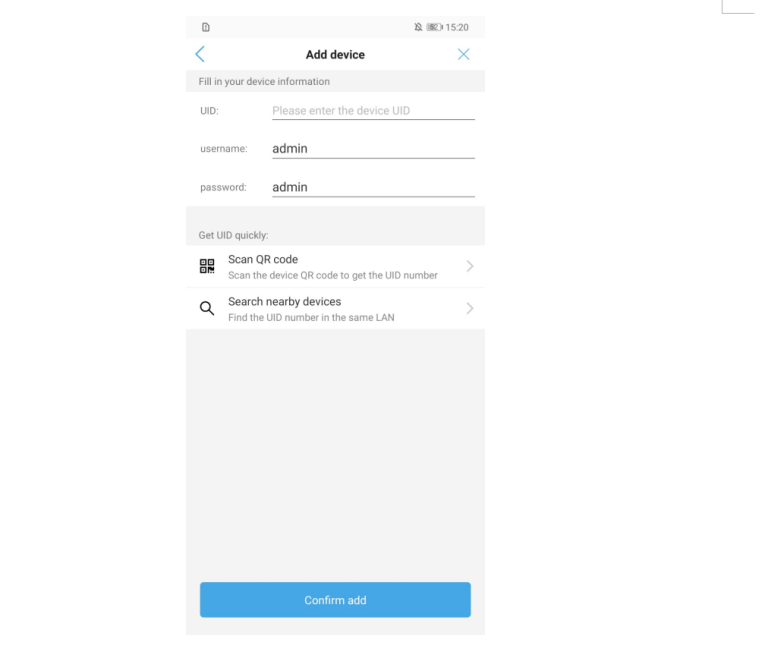
Delete camera
In the device list interface, long press the camera to be deleted or click the button “setting” to enter the camera setting interface, click the button “delete device” to delete the added camera.
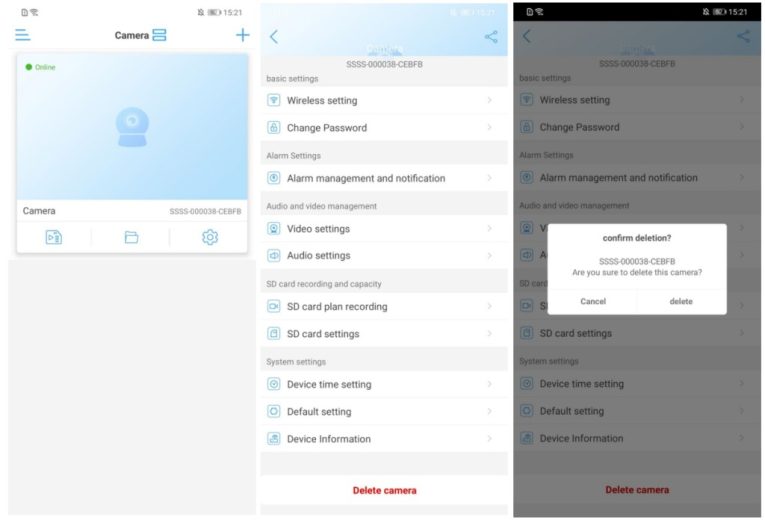
How to set alarm to send Email
1. Setting motion detection
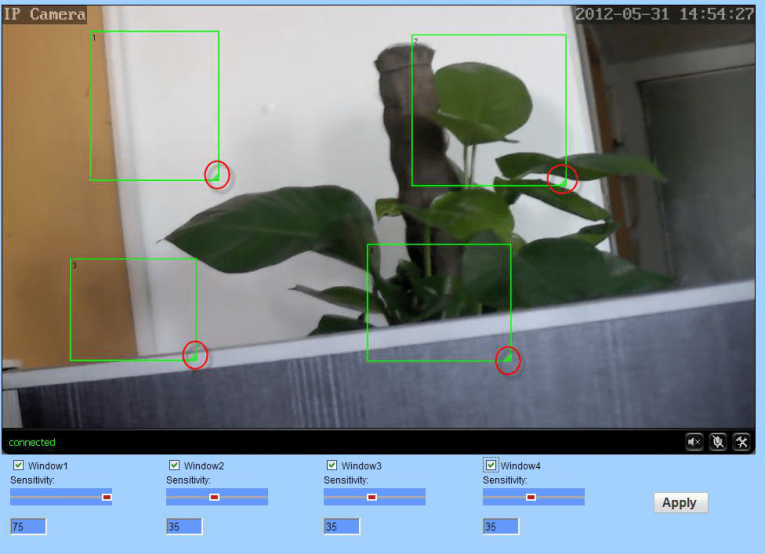
If you want to monitor a zone fixed, when the zone has exception, it enables alarm, you can choose motion detection function. Settings like below.
The equipment can support 4 zones setting, you can enable it through tick the option box at the bottom of page. When enable a zone, the zone box will display on the screen, and list zone number, moving mouse to this zone box, you can drag the box to any position; also can move mouse to red box at the bottom right corner, drag it to change the size. After setting, click apply, motion detection will take effect.
2. Setting alarm Linkage
When alarm triggered, the equipment will alarm with many ways, as shown in below picture:
send alarm and pictures to email
send captured pictures to assigned FTP server
send video recording to assigned FTP server
capture a picture, then save to TF Card
Recording a video for 15 seconds, then save to TF card (including 1-3 seconds warning before video)
linkage Preset: after the alarm, call preset
alarm capture quanity, setting as required (1-3 pieces)
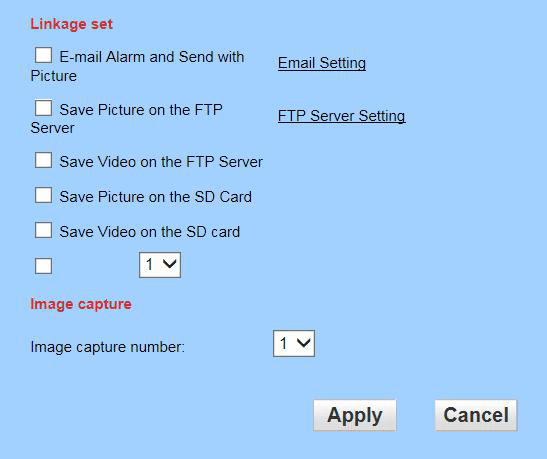
If you want set Email alarm, please tick ”E-mail Alarm and Send with Picture”. and then click “Email setting”
3. Setting Email
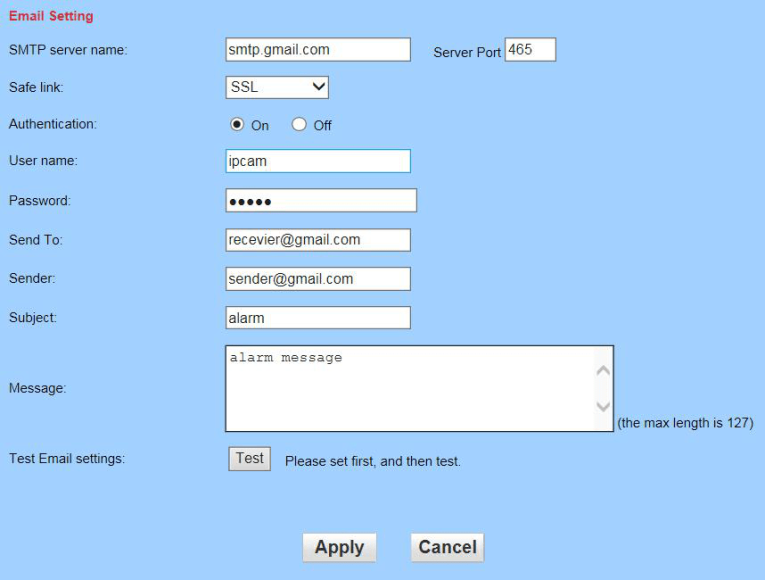
The items in above picture is mandatory fields need to fill in. If the filled content is not qulified, the setting will not be successful. After writing completed, click Apply firstly, then testing, it will reminder testing successfully when finished.
Note:
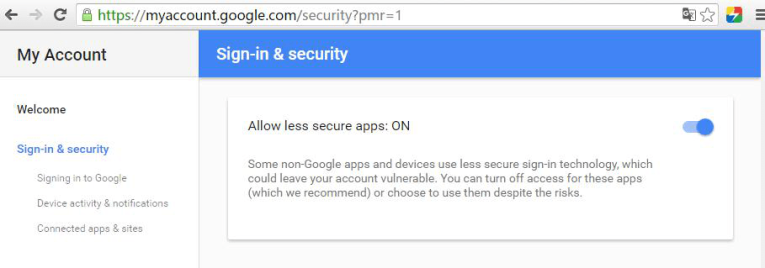
If your Gmail mailbox opened “2-Step Verification”, then you need to set up a separate “app passwords” for camera login,
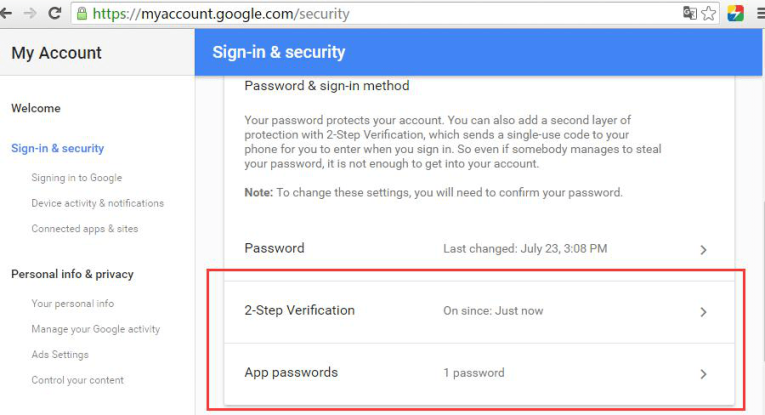
How to set up “app password” you can click on the “Learn more” to get help
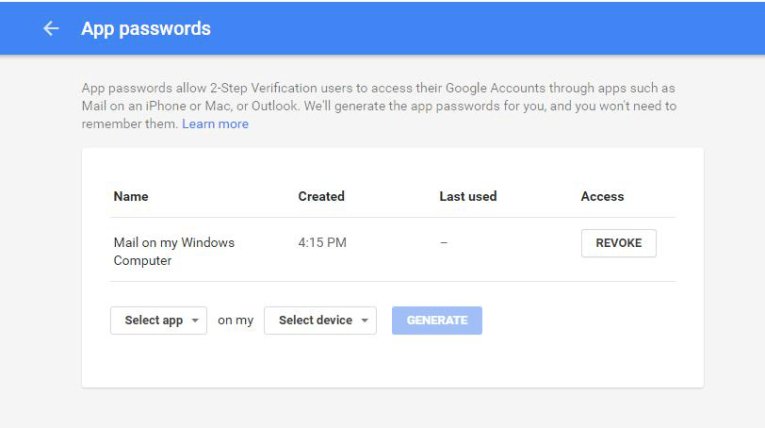
If you do not know the security settings of other mailboxes, we recommended use Gmail.
4. Setting alarm time

The equipment will trigger alarm only after detected alarm in protection period. So you need to select which time to set protection carefully.
Note: When setting time, please adjust system time firstly.
How to set alarm to upload pictures and video to the FTP server
1. Setting motion detection
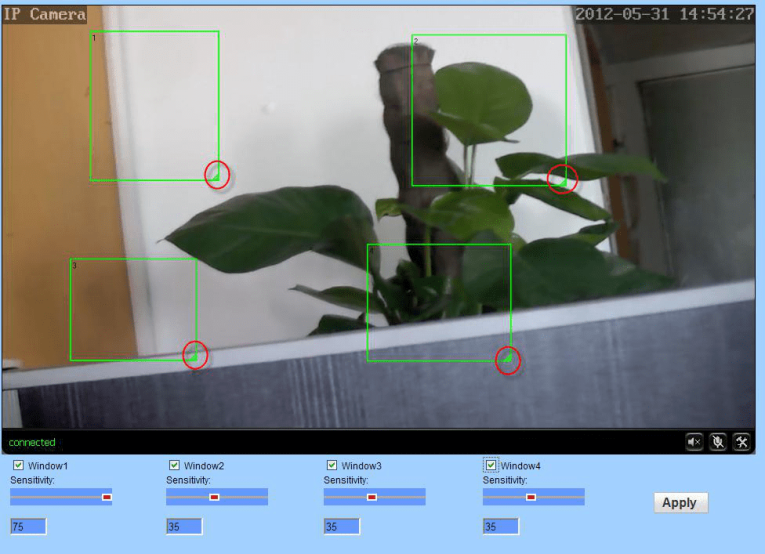
If you want to monitor a zone fixed, when the zone has exception, it enables alarm, you can choose motion detection function.
Settings like below. The equipment can support 4 zones setting, you can enable it through tick the option box at the bottom of page.
When enable a zone, the zone box will display on the screen, and list zone number, moving mouse to this zone box, you can drag the box to any position; also can move mouse to red box at the bottom right corner, drag it to change the size.
After setting, click apply, motion detection will take effect.
2. Setting alarm Linkage
When alarm triggered, the equipment will alarm with many ways, as shown in below picture:
send alarm and pictures to email
send captured pictures to assigned FTP server
send video recording to assigned FTP server
capture a picture, then save to TF Card
Recording a video for 15 seconds, then save to TF card (including 1-3 seconds warning before video)
linkage Preset: after the alarm, call preset
alarm capture quanity, setting as required (1-3 pieces)
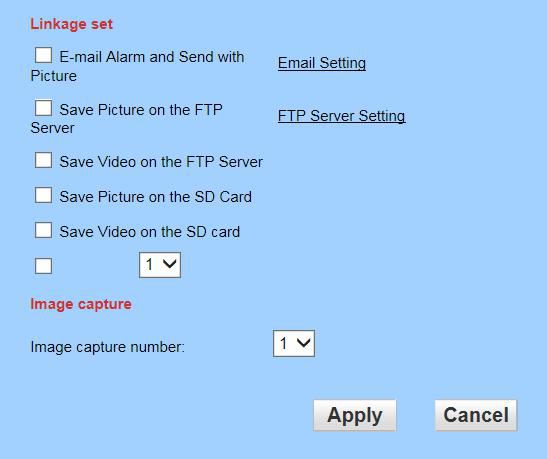
If you want set alarm to upload pictures and video to the FTP server, please tick ”Save Picture on the FTP Server” and ”Save Video on the FTP Server”. and then click “Email setting”
3. Setting FTP Server
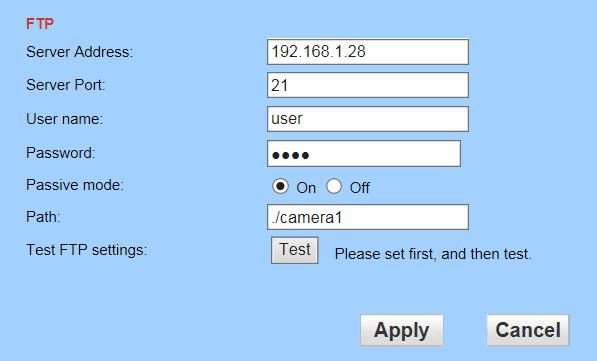
Note: If using FTP function, you need to apply the user name and password from FTP Server firstly, and apply a certain storage space at the same time, also asking the user have anthority to write and build sub-directory to storage space.
4. Setting alarm time

The equipment will trigger alarm only after detected alarm in protection period. So you need to select which time to set protection carefully.
Note: When setting time, please adjust system time firstly.
Timing capture and timing record of SD card
1.Timing capture
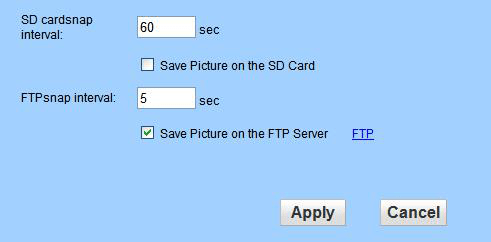
Choosing “save image to SD Card” or “save images to FTP server”, at a regular interval (can be set like above picture), the device will capture images saving to SD Card.
Click “FTP” into set FTP
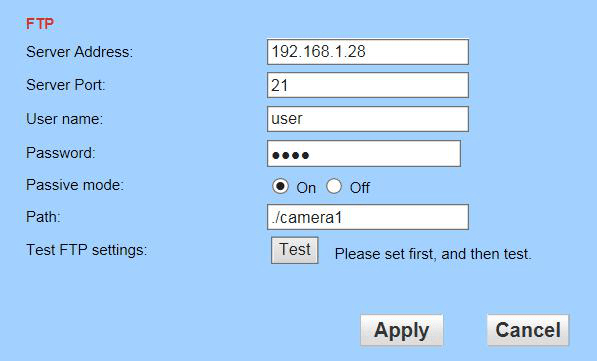
Note: If using FTP function, you need to apply the user name and password from FTP Server firstly, and apply a certain storage space at the same time, also asking the user have anthority to write and build sub-directory to storage space.
2. Timing record
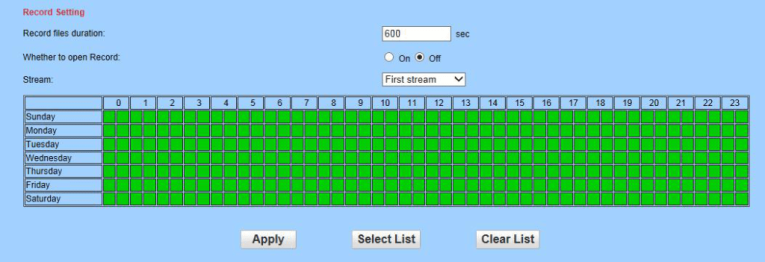
Video file duration: can set video file duration, default is 600 seconds.
Open video: can choose whether open video to TF Card
Stream: can set recording stream
recording time: set timing recording time as required
then confirm the camera support SD card and insert SD card, as shown in below picture:
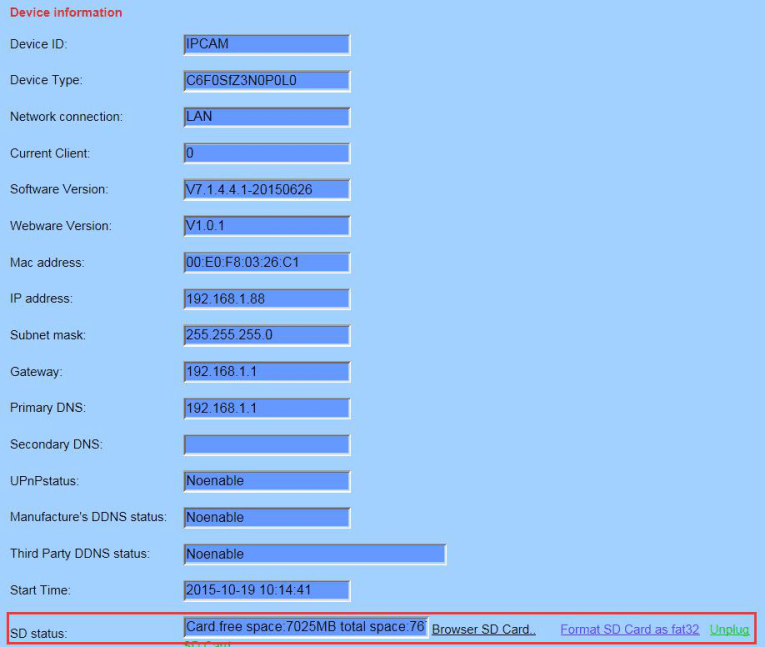
How to view pictures card and download video of SD
Click “SD card” button in IE home page of camera.
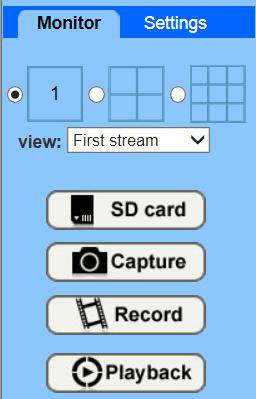
Page will display the date of picture and video, select date.
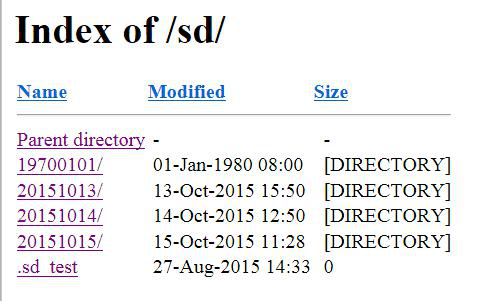
Images folder to store pictures, record folder store videos.
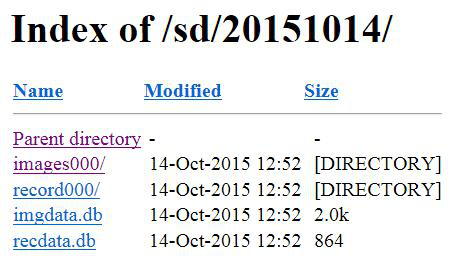
Open images folder, click the images file name directly view picture.
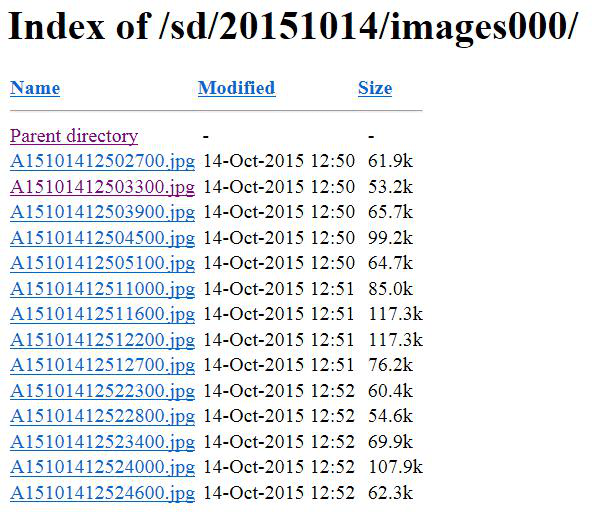
Open record folder, click the record file name to download video.
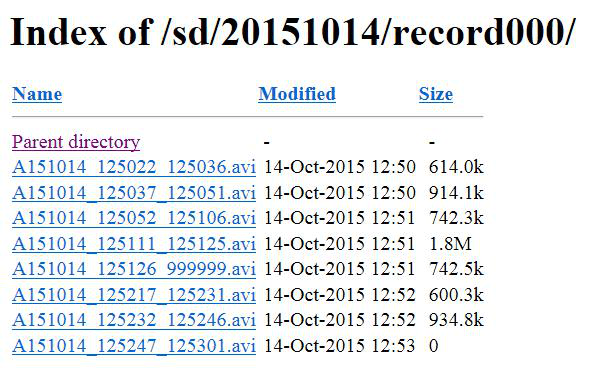
CAMHI IP Camera Port mapping setting method
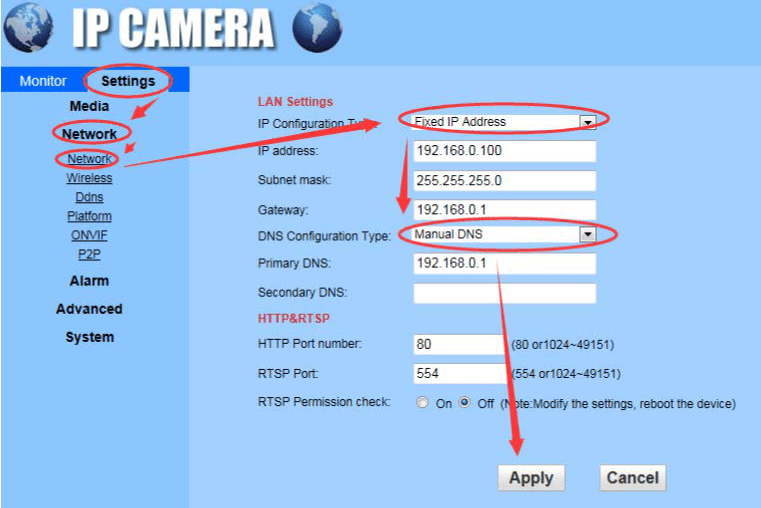
2.Please modify HTTP port number.
The device HTTP port mapping to the external network router,
“External ports”: This port is corresponding to the access requirement of outside network
“Internal Port”: port for this equipment
“Service agreement” selects “ALL”
“IP address”: LAN IP address of the camera.
NOTE:
If your router supports UPNP function, you can also use UPNP port mapping automatically.
UPNP stands for universal plug and play, if you started UPNP, once the IP camera was connected into the LAN, it will communicate with the router of the LAN.
It will request the router to open a port to forward its own port. User doesn’t need to log in the router to set the port forwarding.
users in the use of the function, need to confirm a router also is enabled UPNP; Because many router model, not necessarily can very good support UPNP, testing and supporting the router is very good with, or suggest not start the function. At present test and TP-LINK router cooperate good.
